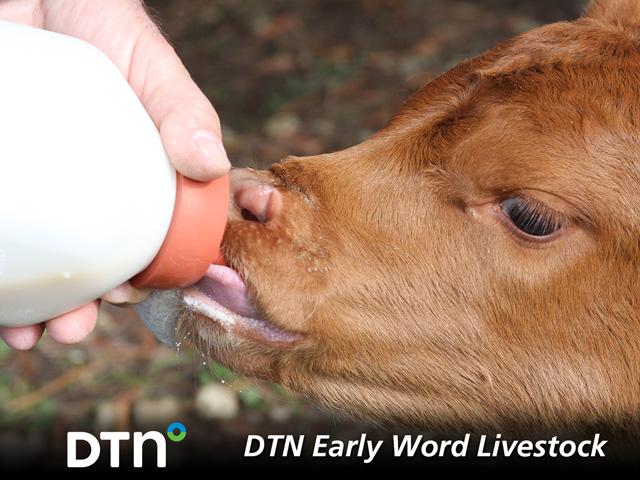DTN Early Word Livestock Comments
Hog Market Pressure Expected Following Hogs and Pigs Report
Cattle: Steady Futures: Mixed Live Equiv $136.21 -0.99*
Hogs: Lower Futures: Lower Lean Equiv $ 70.00 -2.63**
* based on formula estimating live cattle equivalent of gross packer revenue
** based on formula estimating lean hog equivalent of gross packer revenue
General Comments:
Cash cattle is expected to have set the market range for the week with trade over the last couple of days hovering around $95 to $97 per cwt live basis and $152 to $156 per cwt. This is generally steady to $2 per cwt lower than midweek levels, and $5 to $8 per cwt lower than last week's price levels. There could be some clean-up trade on Friday, but it is unlikely that any significant developments in price levels will develop. Compared to the past few weeks, cash cattle prices have remained in a relatively narrow trading range, which is encouraging. The fact that prices are not swinging within a $10 to $20 price everyday means that some additional cash market structure is starting to return to the volatile cash market of the last two months. This will allow feeders to get a better feel for where markets are moving rather than having to wait until next week when price averages are released. Futures trade is expected mixed early Friday morning. The underlying firmness in feeder cattle futures driven by stronger cash feeder cattle sales through the week as well as increasing overall open interest building through late June is expected to help build on support levels at or above the $96 per cwt price levels in spot month August contracts. Friday slaughter is expected at 118,000 head.
Early movement in lean hog trade Friday morning is expected to be focused on the quarterly Hogs and Pigs report. Price pressure is likely to quickly develop in nearby contracts as bearish overall hog numbers compared to pre-report estimates are likely to put pressure on most 2020 contract months. Total hog supplies as of June 1 are 5% above year-ago levels. The expectation that packer shutdowns and a growing hog supply going into the COVID-19 pandemic makes it obvious that hog numbers are actively increasing. But the fact that hogs over 120 pounds have seen the largest increase in numbers will not only create concerns of a backlogged hog supply over the near term, but well into fall. The reduction of hogs kept for breeding as of June 1 and reduced farrowing intentions is expected to cause long-term support with a smaller hog herd heading into 2021. This may spark moderate-to-firm buyer support in deferred contracts Friday. Cash hog prices are expected $1 lower to 50 cents higher with most bids expected steady to weak. Slaughter Friday is expected at 468,000 head. Saturday runs are expected at 309,000 head.
| BULL SIDE | BEAR SIDE | ||
| 1) | Active cash feeder cattle prices are seen through late-week activity with increased buyer support in the active video auctions on Thursday. This support in cash markets continues to focus on long-term support expected to develop in the cattle complex through late fall winter months. | 1) | Cash cattle prices continue to erode lower through the week, with the established market trend showing a $5 to $8 per cwt price drop from last week's levels. The continued pressure in cash cattle markets could continue as boxed beef prices are still unsupported. |
| 2) | August live cattle futures are holding well above short-term support levels of $95.12 per cwt, creating the potential for follow-through buyer support to build through the next couple of weeks. | 2) | Continued concerns of summer beef demand are still creating uncertainty through the entire market. The volatile price movement in wholesale and retail price levels over the last three months have caused many consumers to remain cautious about stepping back into the market to purchase needed supplies. Sluggish food service demand is still expected to slow demand recovery over the near future. |
| 3) | Cash hog prices have started to firm through the end of the week with prices focusing on increased packer demand. This is likely to create more need for packers to get into a more traditional routine of buying hogs, putting more emphasis on cash market movement through the end of June and early July. | 3) | Hog numbers increased 5% over year-ago levels in Thursday's quarterly Hogs and Pigs report. This is well above pre-report estimates and is likely to create moderate-to-active pressure during early Friday trade. |
| 4) | Farrowing intentions in June through November are expected to be significantly reduced with expected farrowing levels to be 95% of year-ago levels. This will help to contract the overall herd size, leading to tighter supplies through most of 2021. | 4) | Increased numbers of hogs weighing 120 to 179 pounds and 180 pounds and higher focused on burdensome supply of hogs ready for market over the next several months. This will continue to put pressure on prices not only in August futures, but will carry the bearish market trend through most of 2020.
|
(c) Copyright 2020 DTN, LLC. All rights reserved.
P[L1] D[0x0] M[300x250] OOP[F] ADUNIT[] T[]



